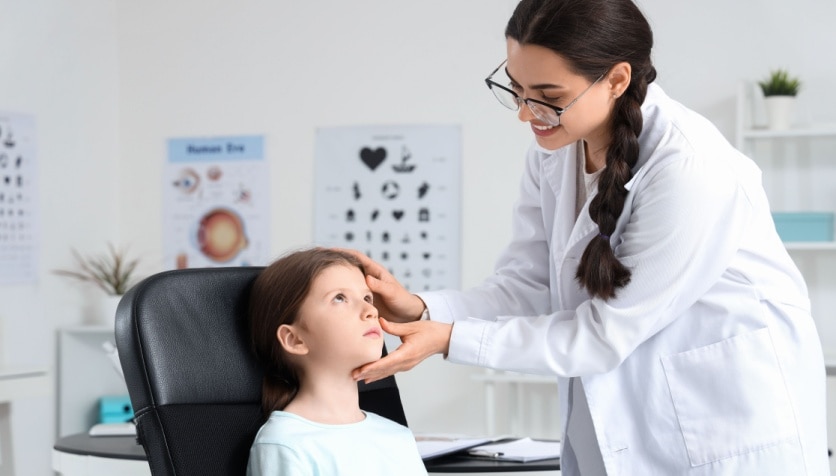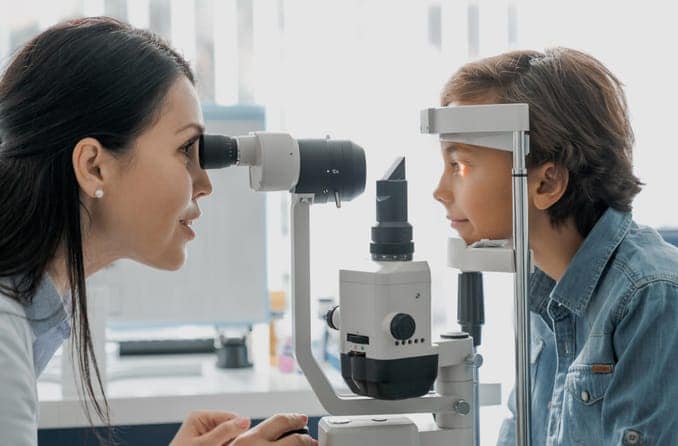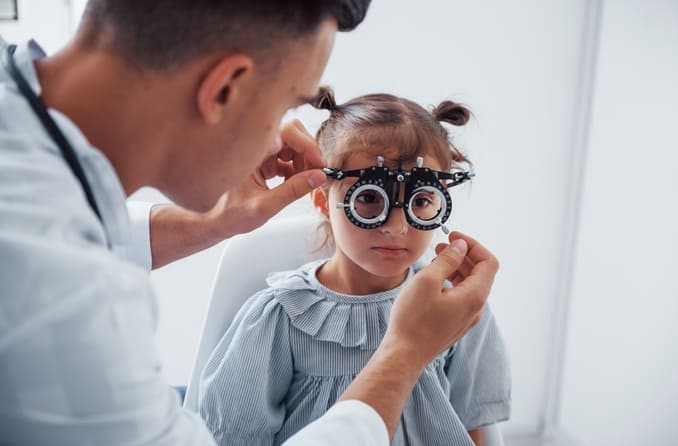Q: My grandson got his glasses at age 10. Now, at 11, he can't see the chalkboard at school. Could he need a new prescription so soon? — C.
A: Please note that it is not possible to give medical advice without actually seeing the patient. The following is only general relevant information that I hope may be helpful.
During puberty, there can be very rapid changes in body growth, including the eyes. This can cause myopia progression and a change in a child's eyeglass prescription in a matter of months.
I recommend you (or his parents) take your grandson to see an eye doctor to check for a prescription change and to exclude other problems that may cause his reduced vision. — Dr. Jovkar
Q: Our active 1-year-old boy needs glasses (+2.00 diopters) to correct his farsightedness and a tendency to cross his eyes. The problem is that he pulls them off the second they go on. We've tried 3/4-inch elastic, holding his arms, tape... He just struggles and cries. How do we get him to wear his glasses? — L.R., Canada
A: This is a tough one — I have no easy answer for you. I sometimes tell parents in your situation to do whatever it takes, including bribes. Make sure the glasses are comfortable and as clean as possible. Usually, small children will accept their glasses in time. But be persistent. Don't let him win this war, as his vision may be at stake. Good luck! — Dr. Dubow
[Read more about strabismus.]
Q: Can certain images, like vertical or horizontal stripes, if looked at by an infant cause or worsen strabismus or amblyopia? What are the percentages of a cure in infants if detected at three months? — J.G., Alabama
A: Nope. We actually use vertical stripes of different sizes to measure an infant's ability to see. And there are instruments that can tell us an approximate prescription in an infant as well, allowing us to work with infants who have crossed eyes, potential amblyopia, etc.
Although there aren't many practitioners who work with 3-month-olds, it can be done. And the sooner the better. Talk with an eye doctor who specializes in children's vision about your concerns. — Dr. Dubow
Q: My daughter (age 10) is farsighted and has been wearing glasses since age 2. Recently we have suspected she has problems with depth perception. How can she be tested for this, and if there is a problem, how might it be treated? — R.L., California
A: Most eye doctors can test your daughter for depth perception. It is not something you can do easily at home, though.
Depth perception, or stereopsis, is the ability of the eyes to see in 3-D. In other words, each eye looks at an object from a little different viewing angle. The brain takes the two images, one from each eye, and puts them together, allowing you to see in more than one dimension. People with only one eye, or people with eyes that don't work together, don't have depth perception.
In some cases, depth perception problems can be successfully treated with vision therapy. — Dr. Dubow
Q: I have an 11-year-old son who is nearsighted. His doctor suggested that he be fitted with gas permeable contact lenses and reading glasses. She also suggested that he wear bifocals when he's not wearing the contacts. Is this a good idea? — M.H., California
A: I totally agree with using rigid gas permeable (GP) lenses to slow the progression of nearsightedness in children (myopia control). And research shows it's effective.
There's also a special fitting technique with gas permeable contact lenses called orthokeratology that can even reverse certain amounts of childhood myopia. Studies also have shown that bifocals and/or reading glasses can help slow down myopic progression.
I personally feel that GP contact lenses are a better solution in and of themselves, but I do respect those doctors who believe in the value of other treatment options. — Dr. Dubow
Q: My daughter, age 3, has Stickler syndrome. Her main medical problem is severe myopia and she was diagnosed with -25 in both eyes. My ophthalmologist says glasses are of no use to her, but she is too young to keep the contacts in her eyes. She takes them out and throws them away. Is there a surgical procedure I can check into to better her vision? — K.S., Georgia
A: With her high risk of amblyopia (lazy eye) as a result of not wearing her contacts, she might be a surgical candidate. Sounds like she hasn't been fit with comfortable contact lenses. Exhaust this modality of vision correction before going on to surgery. There are very few refractive surgeons with experience in this age group. — Dr. Slonim
Q: My 7-year-old son's teacher thinks he has a convergence insufficiency. What is that, and what can I do about it? — C.H., New York
A: A convergence insufficiency is a condition whereby a person cannot turn their eyes in properly and with comfort, leading to eye strain, fatigue, poor reading skills, poor reading comprehension, double vision, etc. This is worse after reading a while or when tired.
A convergence insufficiency can oftentimes be dealt with through vision therapy. Contact the College of Optometrists in Vision Development for more information. — Dr. Dubow
Q: My child is 4 and has 20/40 vision in both eyes. Should I be concerned, or could this improve with time? — M., Georgia

Read or print this info sheet from the editos of AllAboutVision.com
A: More important than knowing your child is 20/40 is knowing whether he or she is farsighted, nearsighted or has astigmatism. It is also important to know how well your child uses his or her eyes together.
If you have not taken your child in for a professional eye exam, I highly recommend you do so. Your eye doctor will tell you if 20/40 is OK or not. — Dr. Dubow
[See also: free eye exams and eyeglasses for qualifying individuals]
Q: My child is farsighted and has astigmatism and is 9 years old. This has hindered schoolwork to the point that we are behind a whole grade level. Are there any doctors who perform corrective surgery on children in the southeast United States that you can send me contact info on? Thank you. — Teresa
A: I doubt any refractive surgeon would touch a 9-year-old whose prescription is unstable (based on their age). You need to find a good contact lens fitter. — Dr. Slonim
Q: What is microcornea? An ophthalmologist after checking my baby daughter born in February has mentioned this in the report for both the eyes. I am deeply worried. Could you help please? — R.S., India
A: Microcornea is a cornea with a smaller than average diameter (less than 11mm). These corneas tend to be a bit steeper than normal and, therefore, produce myopia (nearsightedness). It can occur as a part of other congenital abnormalities, including the rubella (German measles) syndrome.
If the corneas are not opaque, then treatment is usually not necessary, except to eventually correct the nearsightedness. You should ask your ophthalmologist whether treatment is necessary for your child, if only to put your mind at ease. — Dr. Slonim
[Read more about pediatric ophthalmologists.]
Q: My son has a squint. His glasses are +4.00/+5.00 diopters. Does he have to wear the glasses? What about contacts? He is 4 years old. — J.K., Denmark
A: If by "squint" you mean crossed eyes, yes, he does have to wear the glasses. In fact, with his prescription I would recommend he wear the glasses under any circumstances.
Yes, he can wear contact lenses at an appropriate age. Unless there is some overriding reason, I generally recommend children begin wearing contacts at about age 10 or so, depending on their maturity level. By age 10 most kids can handle their contacts safely on their own (with parental supervision, of course). — Dr. Dubow
Q: Can babies see better than a grownup can? — Danielle, New Jersey
A: No. Babies take three to six months to develop good vision. However, babies can recognize their mother's face almost immediately! — Dr. Dubow
[Read more about infant vision.]
Q: I have a teenage daughter who is nearsighted and wants to wear colored contact lenses. I do not feel she is responsible enough for the proper care and handling of contacts.
Even though she has been warned about sharing cosmetic colored contact lenses with her friends, I have caught her wearing them a couple of times.
Is there literature or a web page you can recommend that shows good pictures about the dangers of swapping lenses? I just need some support. — Mary, Texas
A: I agree, Mom. Your daughter could be treading on dangerous ground by sharing contact lenses with her friends.
Everyone's tears are filled with normal bacteria, but transferring these bacteria to someone else's eyes is not a good idea. If the lenses don't fit, you could develop an eye infection such as pink eye. Your eye also could suffer from a lack of oxygen or develop other problems.
I don't believe in scaring my patients into compliance. Usually a bit of education does the trick. Have your daughter talk to your eye care provider about the risks of poor contact lens habits.
Oh, and by the way, have you considered that your daughter may actually be able to handle contact lens wear with the proper education and monitoring? Contact lens practitioners are usually very adept at handling teenage wearers! — Dr. Dubow
Q: How well do contacts correct strabismus? Is it more noticeable with the lenses in? Can surgery be effective when a child gets older? Is there any correction option other than glasses? — Patti, Connecticut
A: Strabismus is a condition where the eyes turn up, down, in or out. Many people refer to strabismus as "crossed eyes." Contacts can work well with certain kinds of strabismus, making it less noticeable. But contacts can also make some kinds of strabismus more noticeable. Talk to your eye care practitioner about contacts and strabismus.
Yes, surgery can be effective at making the eyes look straight when a child gets older. Again, it depends on the kind of strabismus. You might also think about seeing an eye care practitioner who specializes in vision therapy, a process in which the eyes are trained to be straight, using exercises and computerized stimulation techniques. — Dr. Dubow
Q: My husband has astigmatism in both eyes, and my daughter has been diagnosed with refractive amblyopia, and severe farsightedness in one eye over the other. She just got her glasses and still can't read letters on the television from 15 feet away. Does it take a while to adjust? My husband says the prescription is wrong, but I don't wear glasses, so I wouldn't know. — V.S., Pennsylvania
A: Amblyopia is a condition where one eye does not see as well as the other, even with the best possible correction in place. I don't know how old your daughter is, but I can assure you that it will take a while before you see any improvement in her vision. It may also take a few changes in prescription over several years.
Have you had her examined by an eye care specialist who specializes in vision therapy? These specialists can very often work with amblyopic eyes to get them to "turn themselves on" in the brain.
I would also recommend you consider putting your daughter into contact lenses when she is old enough and responsible enough to handle them. Contact lenses can help the eyes work better together and have equal image sizes in the brain. (The image size can vary from eye to eye when wearing thick eyeglass lenses.)
Contact lenses can also work wonders to enhance a patient's self image, though modern spectacle lenses and frames are much better than they used to be at hiding thick lenses. Good luck! — Dr. Dubow
Q: My daughter is 1 year old and has one pupil that is larger than the other. What is the cause? Her doctor says it should become normal. — J.G., Pennsylvania
A: Approximately 10 percent of people have different-sized pupils (anisocoria). There are tests to rule out certain causes of an anisocoria. These tests usually involve the use of drops. Sometimes the abnormality is not the larger pupil but the smaller one. Without knowing the cause, I can't say whether it will eventually become normal. — Dr. Slonim
Q: I recently adopted a 3-year-old boy. He has made lots of developmental progress — is now able to walk, talk, dress and feed himself and attends a regular preschool (he did very little when he arrived).
My question is about color blindness. He has no concept of color. We thought it was just lack of exposure, but he has shown no progress.
Even his teachers at school have asked if there is a problem, as for them he can only differentiate between dark and light.
We have very little bio or family history.
Could you please tell me where I can find more info on color blindness and what I should do to help my son? — E.W., Massachusetts
A: As far as I know, there is no good way to accurately test a 3-year-old for color perception.
There are some new developments in lens tints and coatings that can help people distinguish between colors, but I believe the patient must be able to perform some fairly sophisticated color vision tests to determine what lenses to prescribe.
I recommend you consult with your eye care practitioner to get more information on color blindness and how to deal with it. — Dr. Dubow
Q: I took my 10-year-old daughter for a routine eye exam, and her doctor said that her optic nerve is swollen. She is scheduled for an MRI. He said it is common in 10-year-old girls or 6th grade level. My question is, will eyeglasses help her, or is it something that will go away over time? — Diane, Massachusetts
A: Eyeglasses will not help. Depending on the MRI, this could represent a pseudopapilledema (false swelling of the optic nerve).
This condition probably doesn't affect her vision. That's why she wasn't complaining about her vision. It is important to let any emergency room doctor that she might ever come in contact with know that she has this, or she will get the million-dollar work-up for a simple headache. — Dr. Slonim
Q: My son, who is 11 years old, is under glaucoma treatment. He has had a pressure curve test, an RHT, and slit lamp examination. All info confirms diagnosis of juvenile hereditary glaucoma, in the early stage. He was given some drops to use regularly, but I was informed some drugs can induce sexual problems due to beta blocking action. Are there new drugs that are more reliable for this illness? — A.G., Argentina
A: Many of the anti-glaucoma medications can have systemic side effects. As the drops are absorbed into the eye, some of the medication gets absorbed into the blood stream and can, therefore, affect other parts of the body.
There are a number of good glaucoma medications. However, each has its own set of potential systemic side effects. The main goal is to keep the high eye pressure under control with the minimal amount of medication.
Some beta blocker type glaucoma medication can cause impotence and/or reduce one's libido. If an unwanted systemic side effect does occur, then another medication may need to be substituted. — Dr. Slonim
Q: How young can a child be examined to foster proactive, preventive care? Can certain problems be prevented or controlled with early diagnosis? — L.B., New York
A: You know, we doctors of optometry have done a poor job of educating the public about this important area. Everyone knows to take their child in for a dental exam — in fact, many schools require it. Yet I've never known a child that could gain knowledge by chewing on their books! Thanks for asking this question.
In general, most kids can have a basic eye exam sometime between the ages of 2 and 3. If a parent suspects a problem, like a turned eye or very poor vision in one or both eyes, there are techniques we can use to examine kids as young as 6 months.
I recommend a basic, baseline exam for the children of my patients around age 3. During that exam, as the child watches a barking doggie and a movie, I can do a quick assessment of the child's eye health as well as their visual status (nearsightedness, farsightedness, astigmatism, straightness, focusing, etc). Fortunately, this can all be done without asking the patient to respond to questions, as most toddlers I know can't do that!
One other very important point — do NOT rely on school screenings! As useful as they are to catch gross problems, they are not eye exams and do not check for all the essentials necessary for good vision and productive learning. — Dr. Dubow
[Read more about eye exams for children.]
Q: My eye doctor told me my son was "farsighted" but that was OK. He's 8 years old, but if he needs a prescription, shouldn't he be wearing glasses? He says he sees fine, but I'm concerned. — H.J., Washington
A: Most children are born farsighted, or "hyperopic" as we say in the trenches. As children mature, this farsightedness usually fades away. Some children keep on fading right into nearsightedness.
Remember, farsightedness means being able to see things better far away, whereas nearsightedness means that things far away are blurry. Small amounts of farsightedness are very normal and do not interfere at all with vision. Larger amounts can cause problems with reading and close work.
It is important for your child to have regular exams to make sure his farsightedness fades to an acceptable level. I am farsighted, so it can't be all that bad, right? — Dr. Dubow
Q: My 3-month-old son was born with bilateral cataracts. He had surgery to remove the cataracts at 4 weeks and 5 weeks of age.
The cataract came back in the right eye, and during the second surgery the doctor noticed he had a subluxed lens. She is not sure if it is a primary condition or secondary caused by the growth of the second cataracts. If it is a primary condition, can you tell me what would cause it? — M.C.
A: The term "secondary cataract" is a bad one and actually refers to the clouding of the posterior capsule, which typically occurs very quickly in infants and children. Sometimes the clouding occurs because a band of scar tissue (fibrosis) develops across the capsule.
Once the "primary cataract " (i.e., the only lens) is removed, it does not grow back. It is not uncommon that some small fragments of the original cataract may have been left behind, which the body will typically reabsorb. Leaving a few fragments (cortex) behind commonly occurs in cataract surgery in both children and adults. — Dr. Slonim
[Read more about congenital cataracts.]
Please note: If you have an urgent question about your eye health, contact your eye care practitioner immediately. This page is designed to provide general information about vision, vision care and vision correction. It is not intended to provide medical advice. If you suspect that you have a vision problem or a condition that requires attention, consult with an eye care professional for advice on the treatment of your own specific condition and for your own particular needs. For more information, read our Terms of Use.
READ NEXT: My child says their new glasses make their vision blurry. What should I do?










